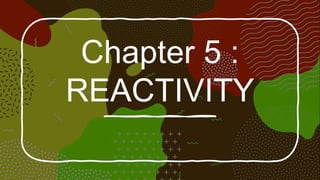
year 9 Science Chapter 5 reactivity.pptx
- 7. Displacement reaction Example 1 Copper sulfate + iron > iron sulfate + copper Iron is more reactive than copper. Iron displace copper. Copper covers the iron strip. Blue copper sulfate solution changes to paler color But if copper metal put into iron sulfate – no reaction
- 8. • Example 2 Copper + silver sulfate > copper sulfate + silver Copper is more reactive than silver. Silver metal formed – settle on copper wire
- 9. 5.2 Using displacement reaction Extracting metals in industry Example: extracting iron Use metal that is more reactive than iron, e.g. Aluminium Aluminium + iron oxide > aluminium oxide + iron This reaction need to be ignited (by heat). The reaction itself will produce a lot of heat (exothermic), thus, the iron produced is in molten form. - Welding railway –the molten iron produced is shaped to join the rails together
- 10. Extract metal from ores • Example 2: Using carbon to extract metals from ores • Ores are rocks that contain metal compound (copper oxide. Zinc oxide, iron oxide …) • Eg :Iron oxide + carbon > Iron + carbon dioxide
- 12. 5.3 Salts Few methods making salt Method 1 : Using acid Salt formed from acid has its name end with –ate, -ide Acid + metal > salt + hydrogen e.g – sodium + hydrochloric acid > sodium chloride + hydrogen (word equation) – symbol equation?
- 15. • Method 2: Using metal oxide Metal oxide + acid > salt + water E.g.
- 16. • Method 3: Using carbonates and acid Carbonates itself are salts – formed by carbonic acid with metal Carbonates can form other salts by reacting with acid Carbonates + acid > salt + water + carbon dioxide e.g. hydrochloric acid + calcium carbonate > calcium chloride + water + carbon dioxide Limestone is made of calcium carbonate. Skeletons of coral in the sea also are of calcium carbonate. When it react with acid, it produces carbon dioxide that dissolve in the sea making it slightly acidic. The salt produced (calcium chloride), make the water salty.
- 17. Hydrochloric acid + Magnesium carbonate > magnesium chloride + water + carbon dioxide MgCO3(aq) + 2HCl(aq) → MgCl2(aq) + CO2(aq) + H2O(l)
- 18. • Method 4: Using acid and alkali (neutralization) Acid + alkali > salt + water E.g. sodium hydroxide + hydrochloric acid > sodium chloride + water NaOH(aq)+HCl(aq)→NaCl(aq)+H2O(l)
- 20. Difference between base and alkali • Both are low in pH, react with acid to form salt (neutralization) • Base are solid, when it dissolves in water, it forms alkali • Metal oxides are bases. If it solubilize in water, it forms alkali, for example sodium oxide. • Some oxides are not soluble in water : copper oxide
- 21. 5.5 Rearranging atoms • In chemical reactions, atoms rearrange themselves to form new compounds • No atom were lost, nor any new ones produced • Example: hydrochloric acid + zinc → zinc chloride + hydrogen 2HCl + Zn → ZnCl2 + H2 All elements in the reactants also present in the products, nothing new produced, and nothing lost
- 22. Conservation of mass • Look at page 196, who is correct? • The mass you begin with in a chemical reaction is the mass you end up with. Nothing is lost nor added. This is the law of conservation of mass But, see page 198, if ..… Calcium carbonate + hydrochloric acid > Calcium chloride + water + carbon dioxide Why mass decrease?
- 23. • Heating magnesium cause mass increase? 1. Weight magnesium in the crucible 2. Heat up, open the lid from time to time 3. All magnesium will turn to ash 4. Weight them again Magnesium + oxygen > magnesium oxide
- 24. Exothermic and endothermic reaction • Energy is involved in all chemical reaction. • It is used to break bonds between elements in the compound, and when new compound is formed, energy is released • Exothermic – energy that released when forming new bonds in the products is more than the energy which break bonds in the reactants. e.g. sodium in water: sodium + water > sodium hydroxide + hydrogen Fizzes vigorously and flames formed. • Endothermic – energy taken in to break bonds in the reactants is higher than the energy released when forming new bonds in the products E.g. Sodium hygencarbonate + citric acid (candy) > sodium citric + water + carbon dioxide